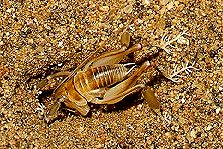
Comicus sp.
Photograph courtesy of Hamish Robertson, South African Museum
The Dune Crickets (Orthoptera: Schizodactylidae) of South Africa
Compiled by John Irish
National Museum, P.O. Box 266, Bloemfontein, 9300 South Africa
 Comicus sp. |
The Dune Crickets (Orthoptera: Schizodactylidae) of South AfricaCompiled by John IrishNational Museum, P.O. Box 266, Bloemfontein, 9300 South Africa |
© Copyright of this page belongs to the author.
Yours is the access since 1st January 2000
The Old World family Schizodactylidae contains two genera, one of which occurs in Africa, and the other (Schizodactylus) from Burma to Turkey. Members of the African genus are wingless. They are abdomino-femoral stridulators. The second and third tarsal joints bear large lateral lobes that enable the animals to jump several metres at a time on sand substrates. Mature males may bear knobs on their cerci. The adults are aparently predacious.
 Comicus capensis Brunner von Wattenwyl 1888: 386.
Comicus capensis Brunner von Wattenwyl 1888: 386.  Comicus arenarius Ramme 1931: 166.
Comicus arenarius Ramme 1931: 166.  Comicus cavillorus Irish 1986: 259.
Comicus cavillorus Irish 1986: 259.  Comicus campestris Irish 1986: 260.
Comicus campestris Irish 1986: 260.  Comicus calaharicus Irish 1986: 261.
Comicus calaharicus Irish 1986: 261.  Comicus calcaris Irish 1986: 262.
Comicus calcaris Irish 1986: 262.